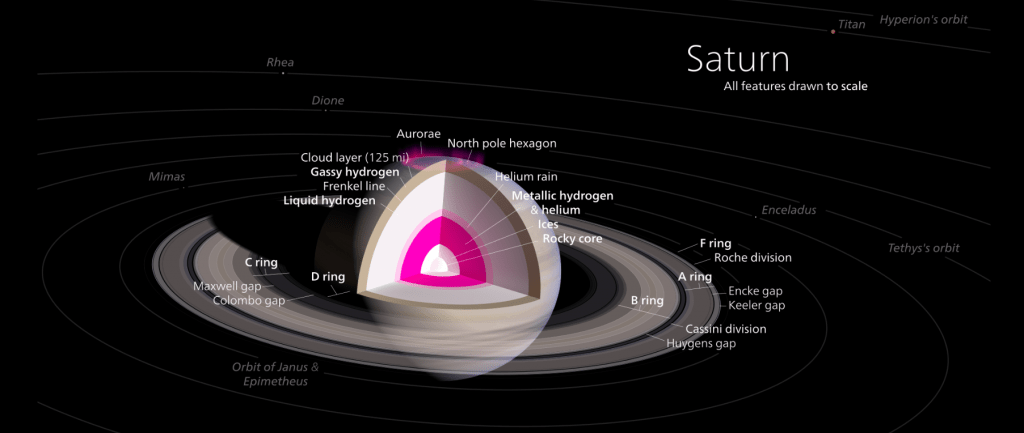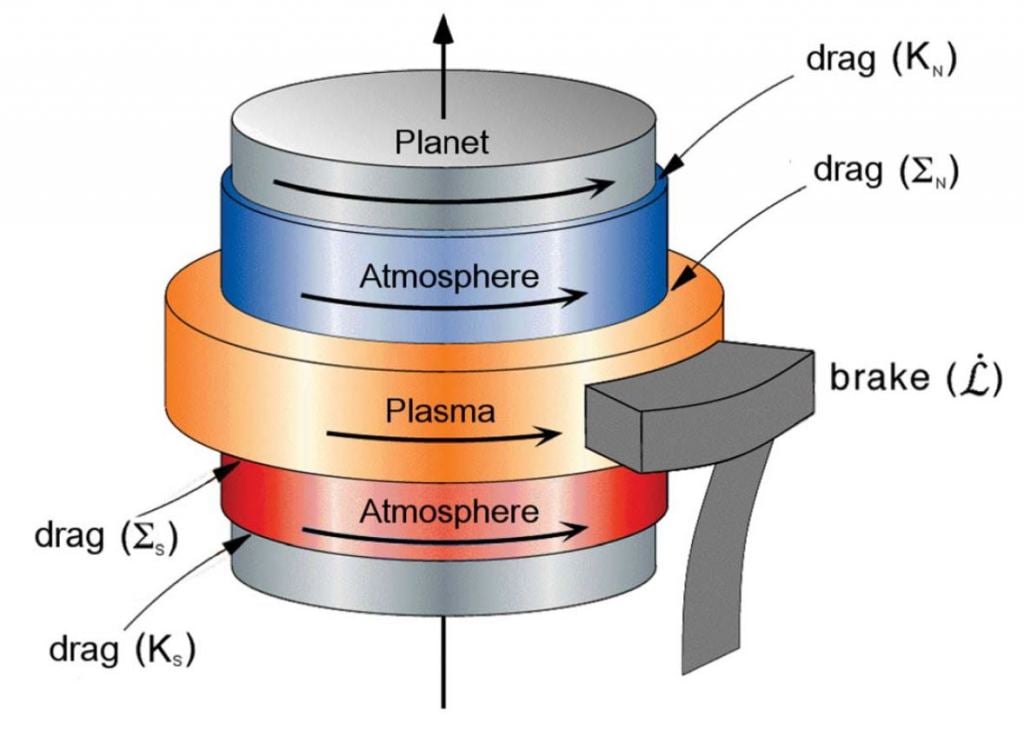For a rocky planet, finding the length of a day can be simple. Just pick a reference point and watch how long it takes to rotate out of view, then back into view. But for planets like Saturn, it's not so simple. There are no surface features to track.
Scientists have spent decades trying to determine Saturn's rotational period. But the gas giant has been reluctant to reveal its secrets. A new study in AGU's *Journal of Geophysical Research: Space Physics* may finally have the answer. The study is titled " Saturn's multiple, variable periodicities: A dual-flywheel model of thermosphere-ionosphere-magnetosphere coupling. "
With a planet like Earth, we know what we're measuring when we measure the rotational period. We're measuring the surface of the planet. But for a gas giant, things are more complex. Which layer of the planet are scientists actually talking about?
Saturn is a multi-layered gas giant, likely with a rocky core. That core is surrounded by a layer of ice, then metallic hydrogen and helium. Then an area of helium rain, further surrounded by a region of liquid hydrogen. Then comes a large region of gaseous hydrogen. Saturn's upper atmosphere is made up of three layers: at the top are clouds of ammonia, under that is ammonium hydrosulphide, and below that are clouds of water vapour.
When scientists talk about Saturn's rotational period, they're talking about the upper atmosphere. It's the only part of the planet that can really be measured.
Scientists look at the radio frequency patterns a gas giant emits to determine its length of day. The difficulty with Saturn is that it only emits low-frequency radio patterns that the Earth's atmosphere blocks. This is in contrast with Jupiter, which emits higher frequency patterns that pass through Earth's atmosphere. Because of that, scientists were able to work out Jupiter's rotational period before the advent of spacecraft.
Saturn had to wait until 1980 and 1981, when Voyager 1 and Voyager 2 visited and collected data. At that time, they measured the rotational period at 10 hours, 40 minutes. That was the best measurement available at the time, and it stuck. For two decades.
But then Cassini visited Saturn, and spent 13 years studying it and its moons. Astronomers were astonished to find that Saturn's rotational period had changed. Cassini data showed that in the twenty years between Voyagers and Cassini—an insignificant amount of time in the life of a planet— the length of day had changed.
“In about 2004 we saw the period had changed by 6 minutes, about 1 percent.” Duane Pontius of Birmingham-Southern College in Alabama, Study Co-Author.
Cassini showed that the rotational period had changed by 6 minutes, or about 1 percent.
"In about 2004 we saw the period had changed by 6 minutes, about 1 percent," said Duane Pontius of Birmingham-Southern College in Alabama, co-author of the new study. "For a long time, I assumed there was something wrong with the data interpretation," Pontius recalled. "It's just not possible."
How does an entire planet change its rotational period in such a short time? A change of that magnitude should take hundreds of millions of years to occur. But there was more: Cassini also measured electromagnetic patterns showing that the northern and southern hemispheres had different rotational periods.
Saturn's Changing Seasons
Pontius and the other authors wanted to understand what had happened, and why there was a discrepancy in the measurements. Assuming that the Cassini data was being understood correctly, there had to be a reason for the change, and for the difference between hemispheres. They decided to compare Saturn with its closest sibling, Jupiter.
One thing that Saturn has is seasons. Saturn has an axial tilt of almost 27 degrees, which is similar to Earth's 23 degree tilt. Jupiter has only a three degree tilt. Just like Earth, Saturn's north and south hemispheres receive different amounts of energy as it orbits the Sun.
On the outer edge of Saturn's atmosphere is a region of plasma. Pontius and the other authors think that the different amount of UV energy reaching the hemispheres through the seasons interacts with that plasma. In the model they've developed, the variations in UV affects the plasma, creating more or less drag at the intersection of the plasma and the outer atmosphere.
The drag is what determines the rotation of the atmosphere as shown by radio wave emissions, and that rotation changes according to the season we're observing.
The drag from the plasma is what slows down the rotation, giving us the rotation period signaled by the radio emissions. As the season changes, the plasma drag changes, and so do the radio emissions. Again, it's the radio emissions that scientists measure Saturn's rotational period with, since there are no fixed surface features.
This model developed by Pontius and his colleagues provides an explanation for the change in rotation seen in the 20 years between the Voyagers and Cassini. This measurement is only for Saturn's surface layers, though. The rocky core, which is between 9-22 times the mass of Earth, is hidden and inscrutable under tens of thousands of kilometers of atmosphere.
More:
- Press Release: Making sense of Saturn’s impossible rotation
- Scientific Paper: Saturn's multiple, variable periodicities: A dual?flywheel model of thermosphere?ionosphere?magnetosphere coupling
- ESA Cassini-Huygens: Saturn's Atmosphere
 Universe Today
Universe Today


